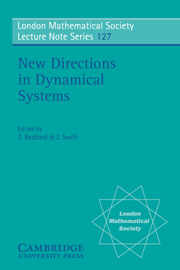Book contents
- Frontmatter
- Contents
- Preface
- Introduction
- Universality and Renormalisation in Dynamical Systems
- Smooth Dynamics on the Interval (with an emphasis on quadratic-like maps)
- Global Bifurcations in Flows
- Knots and Orbit Genealogies in Nonlinear Oscillators
- Limit Cycles of Polynomial Systems – Some Recent Developments
- Bifurcations with Symmetry
Universality and Renormalisation in Dynamical Systems
Published online by Cambridge University Press: 23 December 2009
- Frontmatter
- Contents
- Preface
- Introduction
- Universality and Renormalisation in Dynamical Systems
- Smooth Dynamics on the Interval (with an emphasis on quadratic-like maps)
- Global Bifurcations in Flows
- Knots and Orbit Genealogies in Nonlinear Oscillators
- Limit Cycles of Polynomial Systems – Some Recent Developments
- Bifurcations with Symmetry
Summary
INTRODUCTION.
The renormalisation group formalism has lead to a number of fruitful developments in our understanding of the “transition to chaos”. The best known examples concern the quantitative universality of period-doubling cascades and the breakdown of invariant circles in dissipative and area-preserving maps. This paper is meant to be an introduction to, and biased review of, these ideas.
On period-doubling, I just give a relatively brief review of the basic ideas for unimodal maps of the interval. I do not touch upon period-doubling in area-preserving maps because the theory is so similar. The interested reader is referred to Bountis (1981), Benettin, Cercignani, Galgani & Giorgilli (1980), Benettin, Galgani & Giorgilli (1980), Collet, Eckmann & Koch (1981a), Eckmann, Koch & Wittwer (1982), and Greene, MacKay, Vivaldi & Feigenbaum (1981).
After dealing with period-doubling, I discuss the theory of critical circle maps, especially those with golden-mean rotation number. This leads in turn to a theory for the breakup of invariant circles of dissipative maps with golden-mean rotation number. A natural extension is then to the case of area-preserving twist maps and in Section 4 the theory in Sections 2 and 3 is applied to study the breakdown of the last homotopically non-trivial invariant circle. There is an interesting related theory due to Manton and Nauenberg (1983) which deals with the universal small-scale,structure found in the boundaries of Siegel domains of rational maps of the Riemann sphere. I shall not discuss it here because of lack of space and because the underlying ideas are similar. The interested reader is referred to Manton & Nauenberg (1983) and Widom (1983).
- Type
- Chapter
- Information
- New Directions in Dynamical Systems , pp. 1 - 56Publisher: Cambridge University PressPrint publication year: 1988
- 5
- Cited by



